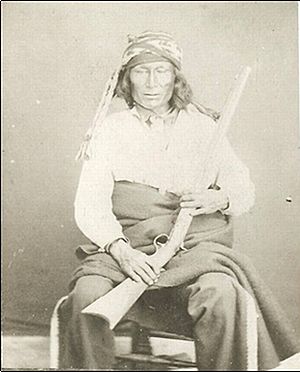Kill Eagle facts for kids
Quick facts for kids
Kill Eagle
|
|
|---|---|
| Waŋblí Kté | |

Portrait attributed to William R. Cross, circa. 1882
|
|
| Sihasapa, Lakota leader | |
| Personal details | |
| Born | c. 1827 probably South Dakota |
| Died | 1885 Standing Rock Indian Reservation |
| Spouse | First Woman |
Kill Eagle, whose Lakota name was Waŋblí Kte, was an important leader of the Sihasapa (Blackfeet) band of Lakota people. He lived from about 1827 to 1885. He was a key figure during a time when Native American tribes faced many changes.
Contents
Kill Eagle's Early Life
Kill Eagle was born around 1827. His father was from the Brulé tribe, and his mother was Sihasapa. His father might have been the first leader of a small Sihasapa group called the Wazhazha. Kill Eagle became well-known by joining a "soldiers society," which were groups that helped keep order in the tribe. In 1864, he helped bring a white captive named Fanny Kelly back to her people.
By 1866, Kill Eagle took over his father's role as leader of the Wazhazha band. He signed the Treaty of 1868 at Fort Rice. This treaty meant his band would live on the Great Sioux Reservation. By the early 1870s, his band was the second largest among the Sihasapa. They settled near the Standing Rock Agency in what is now northern South Dakota. They tried farming and received food and supplies from the government.
The Great Sioux War
In the spring of 1876, the government stopped selling ammunition to the Lakota people. This was part of a growing conflict over the Black Hills. The ban was meant to stop "non-treaty" bands, like Sitting Bull's, from getting weapons. But it also affected friendly bands, like Kill Eagle's.
Caught in the Conflict
Kill Eagle worried that his people did not have enough food. So, in May 1876, he left Standing Rock with about 26 families to hunt buffalo. This was against the rules. The rest of his band stayed at Standing Rock.
Kill Eagle's group successfully hunted buffalo. But then, they accidentally joined a large Native American village. This village had gathered for a yearly sundance. Soon, Kill Eagle's band found themselves caught up in the Great Sioux War of 1876.
A Voice from the Battle
Kill Eagle chose not to fight against the army at the Battle of the Rosebud. He also seems to have stayed out of the fighting at the Battle of the Little Bighorn.
Kill Eagle and his followers managed to leave the main village. They surrendered at the Standing Rock Agency on September 15, 1876. Army officers interviewed him about the Little Bighorn battle. His comments were shared widely in newspapers. This was one of the first times people heard a Native American perspective of Custer's defeat. He also helped create one of the first maps of the battleground.
For almost a year, Kill Eagle and his followers were treated as prisoners of war. Another Sihasapa leader named Goose led the band during this time.
Life on the Reservation
In 1877, Kill Eagle was again recognized as the leader of the Wazhazha band. He stayed at Standing Rock for the rest of his life. A census taken in September 1881 showed Kill Eagle as the leader of a small band. It had 25 families and 123 people.
Kill Eagle's own family included his wife, First Born, and three daughters. Their names were Medicine Woman, Foolish Woman, and Pretty Face. The census also noted that he had four horses, five cows, two dogs, and twelve chickens. He had also farmed two acres of land and grown corn.
Kill Eagle's name stopped appearing in records in 1885. This suggests he passed away sometime that year.


